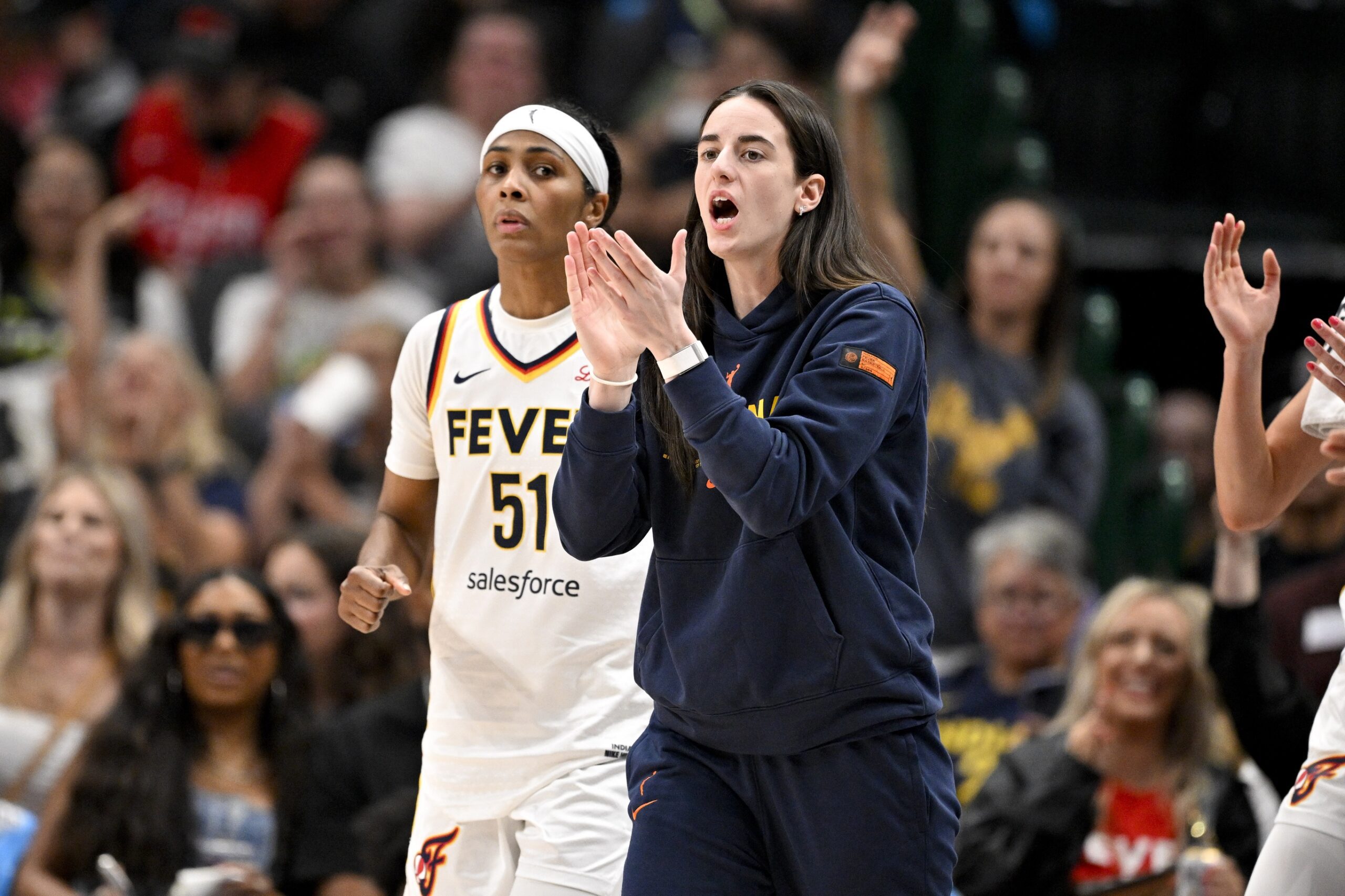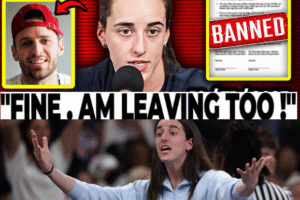For years, Sydney Colson has been one of the WNBA’s most universally liked personalities. A savvy veteran guard, a WNBA champion, and a genuinely hilarious and engaging presence, she has built a career on not just her skill but her character. She is, by all accounts, a fantastic teammate and a beloved figure across the league.
Which is why it sent a shockwave through the WNBA community when Colson sat down for a candid conversation on Aaliyah Boston’s podcast and laid bare a disturbing new reality.
Ever since she signed with the Indiana Fever, Sydney Colson has received more hate, negativity, and “active dislike” than at any other point in her entire professional career.
In a stunningly frank admission, Colson confirmed what many fans have suspected but few players have been willing to say so explicitly: there is a dark, toxic cloud surrounding the Indiana Fever, and its players are paying the price. The reason, she admitted, had nothing to do with her. The vitriol wasn’t aimed at Sydney Colson the player or Sydney Colson the person. It was aimed at Sydney Colson, the Indiana Fever guard.
“I’m not used to this,” Colson explained, noting that while some may not have always found her “hilarious,” the general consensus has always been positive. “For the most part, people have liked me and have admired me from the outside… So once I got here and was experiencing people’s disapproval, it didn’t really fade me… [I realized] I’m probably exactly where I need to be.”

That last sentiment is a powerful one. For Colson, a veteran who has played for multiple franchises, this sudden, irrational wave of hate was a sign. It was confirmation that the animosity was not only unjustified but, in a strange way, a validation that she was in a position that threatened an established order. When people hate you for “no reason,” she reasoned, it says more about them than it does about you.
But what, exactly, is that “reason”? The transcript and the context of the entire WNBA season point to one, undeniable factor: Caitlin Clark.
Colson’s testimony is arguably the most significant piece of firsthand evidence validating the theory that a specific, vocal, and venomous segment of the WNBA fandom, and perhaps even some within its ecosystem, resents the Indiana Fever for the attention they receive due to their superstar rookie. Any player who signs with the Fever, it seems, becomes “tainted by association.”
This isn’t just about on-court rivalries, which are a healthy and necessary part of sports. This is something far uglier. Colson, a respected league figure, was “shocked” by the intensity of the negativity. It wasn’t just criticism; it was personal.
The phenomenon was perhaps best illustrated by the “DeWanna Bonner” comparison. Bonner, a fantastic player in her own right, left the Fever and was, as the podcast discussion noted, seemingly “welcomed right back into the good graces” of the broader WNBA community. The hate that had been directed at her while she wore a Fever jersey simply… evaporated. This pattern sends a clear and troubling message: the problem isn’t the player; it’s the uniform.
Colson’s experience paints a picture of an almost impossible situation for every single player on the Fever roster. They exist in a constant, high-pressure “no-win” scenario.
If they are successful on the court, they are accused of riding Clark’s coattails or benefiting from a media-driven narrative. If they struggle, they are mocked as “liabilities” who are holding the superstar back. If they dare to defend their teammate or speak positively about their team culture, they are dismissed as “fake” or simply trying to curry favor. And if they stay quiet, they are accused of being “jealous” or unsupportive.
There is no correct answer. There is no action they can take that will satisfy the haters, because the hate, as Colson herself identified, isn’t rational.
This toxic environment isn’t just an external problem for fans to deal with; it has tangible, internal consequences. Colson’s season was complicated further by a torn meniscus, an injury that sidelined her for a significant time. Frustrating under any circumstance, the injury took on a new dimension amidst the “unreasonable hatred” being thrown at her and her team.
But true to her veteran-leader status, Colson revealed that the injury forced her into a new role. It “made me an even more vocal leader,” she said. “It made me pay attention to things… that other people had going on so I could be more tapped into if they’re having a hard time.”
This comment is perhaps one of the most telling. Colson recognized that her teammates—Aaliyah Boston, Lexi Hull, Kelsey Mitchell, and others—were also struggling under the weight of this negativity. Her role as a leader was not just to manage her own game, but to help her teammates “mentally and emotionally get through these difficult situations.”
The fact that the team needed this level of emotional and mental support to simply endure a WNBA season speaks volumes. It reveals that the toxicity was pervasive, affecting multiple players on the roster who needed a veteran’s shoulder to lean on.
The irrationality of it all is staggering. The podcast discussion noted that even Lexi Hull, a hardworking role player known for her quiet professionalism, receives hate. Her “crime”? She does her job, plays her role, and is close friends with Caitlin Clark. In the warped view of the anti-Fever contingent, this is apparently a punishable offense.
For the WNBA, this entire situation is deeply problematic for its future growth. The league is finally achieving the mainstream attention it has deserved for decades, largely on the back of a generational talent in Clark and a compelling, watchable team in the Fever. This should be a moment of pure celebration.
Instead, as Colson’s experience shows, there is a strange and powerful resentment from a part of the fan base that seems to prefer the league remain a small, niche entity rather than “grow behind a popular team and player.” The hate isn’t just disagreement; it’s personal attacks and, as mentioned in the analysis, even “slurs” that cross all lines of acceptable discourse.
This kind of environment doesn’t just hurt the players; it makes the WNBA as a whole look petty, unwelcoming, and unwelcoming to the millions of new fans who are trying to engage with the sport.
Perhaps the most absurd part of all this is that, by all accounts, Sydney Colson wanted to be in Indiana. This wasn’t a last-resort signing. She was excited to play with Kelsey Mitchell. She recognized that her own high-energy, comedic personality would likely mesh well with Clark’s. She saw the Fever as a “really good fit” for her style and her personality. She made a choice to be there, and for that, she was punished.

Her honesty is refreshing and, frankly, necessary. By “saying the quiet part out loud,” Colson has given a voice to the unspoken reality that Fever players have been living. She has validated the experiences of fans who have been defending the team all season, insisting that the treatment they receive “isn’t normal.”
It is, as Colson’s testimony confirms, “uniquely toxic.”
The good news is that this team, forged in an unexpected fire, seems to have developed a powerful bond. Colson’s mindset—”I’m probably exactly where I need to be”—is the perfect antidote to irrational hate. Her focus is on her teammates, on her own joy, and on the game itself, not on “other people’s approval.”
That is the mindset of a champion. And it’s the exact kind of leadership that has not only helped the Indiana Fever navigate an unprecedented storm of negativity but has also been a key ingredient in their surprising success. Many teams, as the analysis pointed out, “underestimated Indiana,” expecting an easy win. They “bought into the narrative” that the Fever were a one-player team, and they were “totally embarrassed” when Indiana’s tough, cohesive, and deeply motivated roster beat them.
Sydney Colson may have joined the Fever and discovered a level of toxicity she never expected, but in doing so, she also found a new purpose: to be the leader her team needed to survive it.



